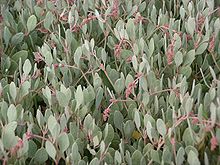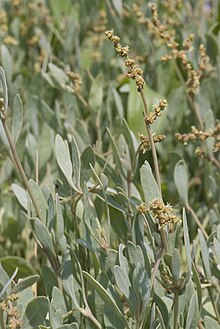Purslane Wedge
| Purslane Wedge | ||||||||||||
|---|---|---|---|---|---|---|---|---|---|---|---|---|

Purslane wedge ( Halimione portulacoides ) |
||||||||||||
| Systematics | ||||||||||||
|
||||||||||||
| Scientific name | ||||||||||||
| Halimione portulacoides | ||||||||||||
| ( L. ) Aellen |
The purslane wedge ( Halimione portulacoides ), also known as beach salt , is a species of the foxtail family (Amaranthaceae). It is an element of the salt plant corridors . The German common name refers to the fact that the taste of its leaves is reminiscent of the vegetable plant purslane .
description
features
The purslane wedge is an evergreen , perennial plant that reaches heights of between 15 and 80 centimeters. The gray and woody stem axes grow prostrate or ascending. The leaves are arranged opposite one another on the stem axis, the lower ones heaped in clusters. The gray-green, simple leaf blades are up to 7 centimeters long in outline, obovate to elliptical-lanceolate and with entire margins. On the surface of the leaf there are very small hairs consisting of only two cells. They are used to regulate the salt content of the plant . After excess salt has been stored in the hairs, the hairs either break off or burst.
Inflorescence and flower
The flowering period extends from July to September. The inconspicuous greenish-yellow flowers sit in spiky inflorescences. They are single sexed ( monoecious ). The male flowers have no bracts , they contain four to five bracts ( tepals ) and four to five stamens . The female flowers are enveloped by two large, up to the top connected, three-lobed pre-leaves, the lobes of which are almost the same size. The bracts are absent from the female flowers, they contain only one ovary .
Fruit and seed
The fruits are sessile. Characteristic of the genus of halimione ( Halimione is) that the pericarp tightly adheres to the page forward. The seed stands upright, its root points upwards in the fruit. The seed coat is thin and membranous.
Chromosome number
The number of chromosomes is 2n = 36.
Photosynthetic pathway
The purslane salt marsh is a C 3 plant .
ecology
Salt plant
The purslane wedge is a halophyte . It pumps the salt absorbed through the roots into so-called bladder or desalination hairs . These are hairs ( trichomes ) on the leaf surface, into which salt ions are actively transported. The hair dies and the salt is removed from the plant. The bladder hairs cover the leaves and the stem as a silvery, shiny layer.
The more sodium chloride containing soil, the more sodium - ion accumulates in the plant in itself. Up to medium salt concentrations, salt promotes growth. At higher concentrations, the rate of photosynthesis decreases, this is mainly caused by a restricted gas exchange.
Heavy metal tolerance
Like other plant species of the salt marsh , the purslane wedge can tolerate heavy metals in the soil . In soils that are contaminated with zinc , lead , cobalt , cadmium , nickel or copper , the roots accumulate significantly more metals than the stems and leaves. In addition, the metals are mainly stuck in the cell walls and thus kept away from the places of cell metabolism . In this way the plant prevents poisoning by the harmful metal ions. Therefore, the purslane wedge report could also be suitable for the phytoremediation of contaminated soils.
Food for insects and fungi
The purslane wedge is a food plant for the larvae of the Baris scolopacea weevil . Henestaris halophilus from the Geocoridae family of bugs and the nymphs of the report bug Parapiesma quadratum suck the sap of the plant. The soft bug Orthotylus moncreaffi also feeds on this species.
The hose fungus Byssothecium circinans lives at the roots . Occasionally, the living plant is attacked by the downy mildew fungus Peronospora farinosa . The saprobiontic fungi Ascochyta obiones , Camarosporium roumeguerei Coniothyrium obiones and Phomopsis piceae forma obiones grow on dead parts of the plant of the purslane wedge .
Occurrence and endangerment
The purslane wedge is widespread on the sea coasts of western and southern Europe and the Mediterranean coasts of North Africa to western Asia. It is also said to occur in Namibia and South Africa .
In Germany, the purslane salt register thrives primarily on the North Sea coast . While it is not considered endangered in Lower Saxony and Bremen, it is classified as endangered in Schleswig-Holstein ( Red List of Endangered Species 2).
The purslane wedge grows along the coast in salt marshes on sandy salt clay soils. Often it dominates the vegetation there . It needs full sun and nitrogen-rich, moist soil. It is regarded as a characteristic of the plant society (association) of the salt marsh turf (Halimionetum portulacoidis Kuhnh.-Lord. 1927).
Systematics
The first publication was made of this kind in 1753 by Carl Linnaeus under the name Atriplex portulacoides in Species Plantarum 2, S. 1053. Paul Aellen separated this way in 1938 as Halimione portulacoides (L.) Aellen of Atriplex , and presented at the same genus Halimione on ( in: Negotiations of the Natural Research Society in Basel , Volume 49, p. 126). In the following years this species was frequently put back to the genus Atriplex .
Phylogenetic studies by Kadereit et al. 2010 showed that Halimione does not belong to the genus Atriplex , but rather exists as a genus of its own.
Synonyms for Halimione portulacoides (L.) Aellen are: Atriplex portulacoides L. , Chenopodium portulacoides (L.) Thunb. , Halimus portulacoides (L.) Dumort. and Obione portulacoides (L.) Moq. , and possibly also Halimus australis T.Nees and Halimus borealis T.Nees .
Halimione portulacoides belongs to the tribe Atripliceae in the subfamily Chenopodioideae within the foxtail family (Amaranthaceae). This family now includes the goosefoot family (Chenopodiaceae).
use
The leaves of the purslane wedge are edible and after careful washing they can be eaten raw as a salad or cooked as a vegetable. They are described as crunchy and meaty with a salty taste.
literature
- Henning Haeupler , Thomas Muer: picture atlas of the fern and flowering plants of Germany (= the fern and flowering plants of Germany. Volume 2). Published by the Federal Agency for Nature Conservation. Ulmer, Stuttgart 2000, ISBN 3-8001-3364-4 (section description).
- E. Oberdorfer: Plant-sociological excursion flora. Ulmer, Stuttgart 1994, ISBN 3-8252-1828-7 (section occurrence)
- Gudrun Kadereit, Evgeny V. Mavrodiev, Elizabeth H. Zacharias & Alexander P. Sukhorukov: Molecular phylogeny of Atripliceae (Chenopodioideae, Chenopodiaceae): Implications for systematics, biogeography, flower and fruit evolution, and the origin of C4 Photosynthesis . In: American Journal of Botany , Volume 97 (10), 2010, p. 1682. (Section description and systematics)
Individual evidence
- ↑ Thorsten-D. Künnemann: Salt marshes. Survival between land and sea. With illustrations by Gunnar Gad. Isensee Verlag, Oldenburg 1997. Page 80 ISBN 3-89598-414-0
- ↑ Chromosome number in Tropicos
- ↑ a b Susana Redondo Gómez et al .: Growth and Photosynthetic Responses to Salinity of the Salt-marsh Shrub Atriplex portulacoides . In: Ann. Bot. , Volume 100 (3), 2007, pp. 555-563. doi : 10.1093 / aob / mcm119 summary
- ^ Ana I. Sousa, Isabel Cac¸ador, Ana I. Lillebø, Miguel A. Pardal: Heavy metal accumulation in Halimione portulacoides: Intra- and extra-cellular metal binding sites . In: Chemosphere 70, 2008, pp. 850-857 PDF file
- ↑ a b Entry in Encyclopedia of Life .
- ↑ P. Uotila: Chenopodiaceae (pro parte majore). - In: Euro + Med Plantbase - the information resource for Euro-Mediterranean plant diversity. Halimione portulacoides (L.) Aellen, 2011. Halimione portulacoides at PESI portal
- ^ Atriplex portulacoides in the Germplasm Resources Information Network (GRIN), USDA , ARS , National Genetic Resources Program. National Germplasm Resources Laboratory, Beltsville, Maryland.
- ↑ a b Purslane wedge report. In: FloraWeb.de.
- ↑ First publication scanned at biodiversitylibrary.org .
- ↑ Entry in The Plant List .
- ↑ Entry in Plants for a Future
Web links
- Purslane Wedge. In: FloraWeb.de.
- Distribution of the purslane wedge report in Germany at FloraWeb
- Distribution map of the purslane wedge report on the PESI portal
- Worldwide distribution at Den virtuella Floran
- Thomas Meyer: Data sheet with identification key and photos at Flora-de: Flora von Deutschland (old name of the website: Flowers in Swabia )
- Photos of the purslane wedge at Encyclopedia of Life

